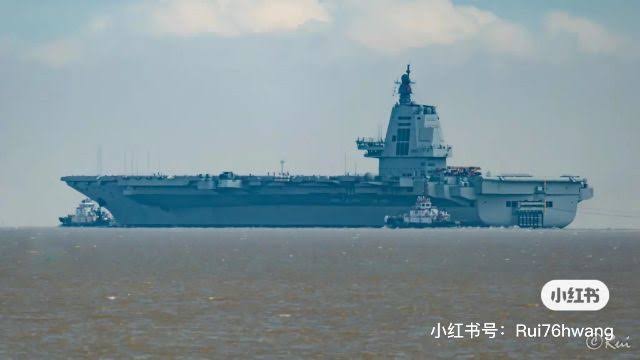China’s Fujian aircraft carrier tests KJ-600 AEW&C takeoff
By Boyko Nikolov
New, albeit blurry, images have surfaced online, allegedly showing China’s latest and most advanced aircraft carrier, Fujian, engaging in another round of sea trials.

Photo credit: Sohu
While details remain scarce, speculation is swirling that the carrier is testing the takeoff capabilities of the KJ-600 AEW&C aircraft, a platform that could dramatically enhance the carrier’s situational awareness and operational reach.
There has been no official confirmation from Beijing – a predictable silence, as China rarely publicizes such milestones in real-time. Still, if the claims are accurate, this development signals a major leap forward for the Fujian, which features an electromagnetic catapult launch system designed to rival the U.S. Navy’s Ford-class carriers.
The KJ-600, which bears a striking resemblance to the U.S. E-2D Advanced Hawkeye, is seen as a critical component of China’s push to create a blue-water navy capable of global power projection. Its successful integration with the Fujian would mark a pivotal achievement in the PLAN’s efforts to modernize its carrier fleet.
While many questions remain – including whether these tests involved a full-weight operational aircraft or a mock-up – the potential implications are undeniable.
The Fujian is not just a testbed; it’s a statement of intent, and every trial brings it closer to becoming a fully operational centerpiece of China’s growing naval ambitions.
The KJ-600 AEW&C [Airborne Early Warning and Control] aircraft represents a significant leap in China’s capability to project power and enhance situational awareness within its naval and aerial operations.
Designed to function as a key component of China’s growing carrier fleet, the KJ-600 is tailored for integration with catapult-equipped carriers like the Fujian. Its design bears a resemblance to the U.S. Navy’s E-2D Advanced Hawkeye, but it is distinct in its application and technology.
The aircraft is equipped with a fixed rotodome mounted above its fuselage, housing a powerful active electronically scanned array [AESA] radar. This radar system is believed to provide 360-degree coverage, enabling it to detect and track multiple air and surface targets simultaneously over a vast range.
Reports suggest that the KJ-600’s radar system can identify stealthy targets, a capability crucial in countering advanced fifth-generation fighters like the F-35.
The integration of AESA technology ensures a high degree of reliability, resistance to jamming, and rapid data processing. Beyond radar capabilities, the KJ-600 features an advanced mission systems suite designed to enhance its command-and-control role.
This includes state-of-the-art signal processing equipment, a robust communication network for secure data links, and an electronic warfare package to provide situational awareness and self-protection.
These systems collectively allow the KJ-600 to serve as an airborne command post, directing friendly forces during complex naval or aerial operations.
The aircraft is powered by twin turboprop engines, likely optimized for extended loiter times and fuel efficiency. This propulsion system provides the endurance needed for prolonged operations over open seas, aligning with the strategic demands of China’s carrier strike groups.
Its airframe design emphasizes stability and reliability, enabling operations from the challenging environment of a moving aircraft carrier deck.Internally, the KJ-600 houses a sophisticated crew station layout designed for optimal mission execution.
The crew is expected to consist of multiple operators, each dedicated to specific tasks such as radar operation, tactical coordination, and communication management.
These workstations are outfitted with high-resolution displays, ergonomic controls, and integrated data-sharing systems, allowing for seamless collaboration and decision-making.
While official details remain limited due to the opaque nature of Chinese military programs, the KJ-600 appears to be a critical element in China’s efforts to close the capability gap with established naval powers.
Its introduction signifies a major enhancement in the People’s Liberation Army Navy’s [PLAN] ability to conduct carrier-based operations with a focus on network-centric warfare and integrated force coordination.
As China continues to refine this platform and integrate it into its carrier strike groups, the KJ-600 will likely play a pivotal role in reshaping the regional balance of power and expanding China’s global reach.
The Chinese aircraft carrier Fujian [Type 003] represents a significant leap in the People’s Liberation Army Navy’s [PLAN] naval capabilities.
Officially launched on June 17, 2022, the Fujian is China’s first fully domestically designed and built aircraft carrier equipped with cutting-edge technologies that rival some of the most advanced carriers in the world.
Its construction reflects China’s ambition to establish a blue-water navy and project power far beyond its shores.
The Fujian features a flat-top design with a displacement of approximately 80,000 metric tons, making it comparable in size to the U.S. Navy’s Nimitz-class carriers.
Unlike China’s first two carriers—the Liaoning and the Shandong—which are equipped with ski-jump ramps for launching aircraft, the Fujian uses an electromagnetic catapult launch system [EMALS].
This is a significant technological advancement that enables the carrier to launch a greater variety of aircraft with higher payloads and at faster rates.
The EMALS system reduces wear and tear on airframes compared to conventional steam catapults, increasing the operational lifespan of the carrier’s air fleet.
The Fujian is expected to accommodate a diverse range of aircraft, including the Shenyang J-15, a carrier-based fighter jet that has undergone several upgrades to enhance its performance. It is also anticipated to deploy the more advanced J-35 stealth fighter, which is still under development.
The J-35, with its low observable design, enhanced electronic warfare capabilities, and extended range, is expected to provide the Fujian with a competitive edge in modern aerial combat scenarios.
Additionally, the Fujian may support KJ-600 carrier-based airborne early warning aircraft, which resemble the U.S. Navy’s E-2D Hawkeye.
These aircraft would significantly improve the carrier’s situational awareness by extending the reach of its radar and providing a comprehensive picture of the battlespace.
In terms of defensive and offensive systems, the Fujian is equipped with advanced phased-array radar systems.
These radars are designed to detect and track multiple targets over long distances, providing the carrier with robust situational awareness and an effective ability to direct air and missile defense operations.
The ship is also believed to feature close-in weapon systems [CIWS] such as the HQ-10 and Type 1130 systems, which are capable of intercepting incoming missiles, drones, and other aerial threats at close range.
The Fujian is powered by a conventional propulsion system, distinguishing it from nuclear-powered carriers such as the U.S. Navy’s Gerald R. Ford class.
While this limits its operational range and endurance, its large size and advanced features mark a substantial improvement over its predecessors.
The ship’s hull design incorporates a modernized approach to stealth, reducing its radar cross-section and improving survivability in contested environments.
Furthermore, the Fujian integrates a comprehensive command and control system, enabling it to coordinate with other naval assets in real-time.
This is particularly crucial for operating as part of carrier strike groups, which combine multiple surface vessels, submarines, and aircraft for a wide range of missions, including power projection, sea control, and maritime security.
Overall, the Fujian signals China’s commitment to building a world-class navy capable of operating globally.
Its technological sophistication and strategic implications underscore its role as a centerpiece of China’s growing maritime ambitions.
While not yet operational, its eventual deployment is expected to significantly enhance the PLAN’s ability to project power and influence across the Indo-Pacific and beyond.




